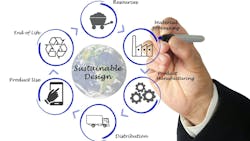Sustainability: The next step in industrial design’s evolution
How we design products has changed drastically, from the simple tools of our ancestors to modern electronics. Within that arc was an important transition—industrialization. Rather than designing a product with an idea of the craftsmanship and tools it would require, industrialization required a more rigid understanding of how the product would come to be in the physical world.
These additional design considerations led to much higher production volumes because the product was designed with the manufacturing process in mind. Products could be made faster and at lower cost through industrial design.
Over time, costs were minimized and creative designs were eked out of the rigid requirements of industrial processes—hence the name industrial design. Unfortunately, one of the variables was missing from the formula for long-term success.
See also: Sustainability, traceability, visibility: New rules and tools for complex manufacturing
Sustainability is the next major inflection point for design, taking many cues from its predecessor while expanding the focus of a successful product design.
The reasons for companies to adopt sustainable design practices as they have industrial design are just as diverse as the methods they will take: They range from achieving net-zero emissions commitments, meeting customer expectations on environmental impact, capturing ESG (Environmental, Social, Governance) investments, and overcoming resource scarcity.
What a sustainability transition means for design
Much like industrial design, sustainable design functions on the complex relationships between the goals of a product, its manufacturability, and its performance in the field. Decisions need to carefully consider various requirements because even seemingly uncomplicated design decisions can have wide-reaching impacts on the overall sustainability of a product.
The material choice can add CO2 emissions from how it is processed into a usable feedstock. Selecting certain suppliers can add additional transportation emissions. Certain manufacturing processes can make a product more difficult to repair. The complexity added from understanding the full sustainability impact of these design choices necessitates a more comprehensive solution, a digital solution.
When 80% of a product’s overall environmental impact is determined in the design phases, it’s important to understand the impacts of decisions from the earliest stages of conceptual design. A comprehensive digital solution enables businesses and designers to easily integrate and examine data from suppliers, simulations, and sensors to make the best decisions possible for their product to be sustainable.
See also: Your competitors are using AI. Why risk falling behind them?
The trick to success is to do this in balance with the traditional business drivers of cost, time, and quality. Integrating these digital tools will enable designers to better navigate these drivers and maximize the positive impacts of their decisions, such as increased recyclability, more efficient manufacturing, and better product performance in use.
How to integrate sustainability, sustainably
To prevent the influx of design complexity burying businesses in an avalanche of data, it’s important to set up a framework and add new processes steadily, perhaps as pilot programs in a larger business or when establishing a new startup. Integrating sustainability into conceptual design, supplier sourcing, detailed design, validation, and design improvement is the key to a successfully sustainable product design.
In conceptual design, sustainability regulations will drive a wider set of design requirements, making it critical to capture and define the relevant sustainability KPIs for a product. To select suppliers effectively, businesses can leverage their digital enterprise to source and compare potential suppliers and logistics networks based on sustainability requirements.
See also: 5 steps for building sustainability into product design
Working from their digital models, designers can then make detailed design decisions such as material selections based on the material properties and associated sustainability scores for light-weighting, flexibility, modularity, and reliability.
Validating a design to ensure it meets sustainability criteria often requires simulations and prototypes across manufacturing and use conditions but can even reflect data gathered during operation to inform service schedules and future design revisions. And with continuous design improvement, the data from real-world use, simulation, and production monitoring can uncover performance gaps, reliability improvements, and refurbishment or upgrade opportunities.
Each of these phases has an important impact on the design of a product, and a business could implement any one of these to see an improvement. The best option is to continue taking steps toward sustainability. Many of the tools to get there already exist, the goal is understanding how to use them in new ways to bring more information into the digital twin from across the lifecycle and ecosystems.
Building a future in sustainable design
Sustainable design is about much more than meeting requirements for a product. It creates a framework from which to innovate on a wider platform than ever before just as industrial design did centuries ago. The difference is that instead of focusing solely on cost, quality, and time, businesses need to understand the impact their products and manufacturing have on the environment.
That shift in understanding can also provide previously unseen opportunities to businesses as they design their next products. Minimizing energy use in manufacturing by designing the product for the manufacturing process reduces emissions and saves operational expenses. Transitioning to circular material systems lowers both associated emissions and material costs, as well as the risk of resource scarcity. Designing repairable products can provide a more stable ongoing revenue stream while promoting brand trust with consumers for designing quality products.
See also: How to improve factory maintenance—and retain frontline workers
However, businesses move into the future with sustainable design, our technology and experience at Siemens is helping make that transition more attainable. Part of that is developing a new mindset to think about sustainability as early as possible in design, but it is also providing the structure, data and tools to achieve success within a more complex web of requirements and benefits.
Going digital is necessary such that businesses can connect the entire value chain and fully understanding a product, its goals, and accompanying challenges to create something successful.
About the Author

Eryn Devola
Eryn Devola is the head of sustainability for Siemens Digital Industries, where she leads the sustainability horizontal market to manage the strategy for profitable sustainability for Siemens and its customers. She has been part of the Siemens team since 2012, most recently as the North America director of sales for Siemens Large Drive Applications. Her career includes roles of increasing responsibility across quality, plant management, operations, and sales.
